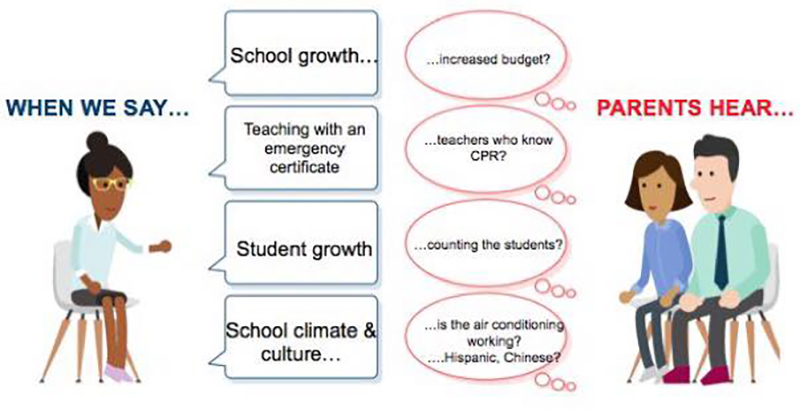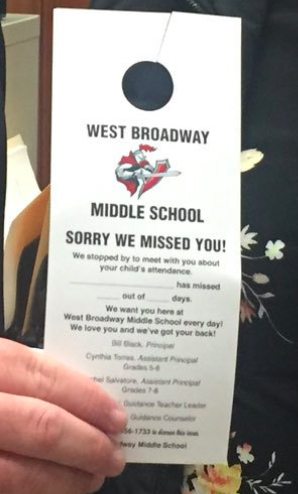Parents Want to Feel Noticed: The Critical Priority of Getting Families Involved in Their Schools Is About Relationships, Not Money

This piece is part of a series on engaging parents and families under the Every Student Succeeds Act, examining from parents’ perspectives how districts and schools can best use new funding to make parents partners in improving education in their communities, and how to measure whether those efforts are working. Click through the grid below to read essays from parents across the country.
Title I, ESSA, parent engagement. Or just “blah blah blah.” At least that’s what most parents hear when those words get thrown around with zero explanation of what they even mean.
These terms and many others blend into the noise that is parenthood in 2018. It’s our job as education advocates, educators, and policymakers to not just explain but humanize these concepts so that the average parent has the information they need to understand the basics of what is happening and, subsequently, the confidence to engage in a system that can feel overwhelming and even unwelcoming.
And the key to doing that lies in one simple word: relationships.
The 1 percent
Schools that serve a high percentage of low-income students are often referred to as Title I schools because they receive additional federal funds. One percent of these funds, according to past and current education law, must be spent on parent engagement, but we are kidding ourselves if we think parent engagement is about money.
It isn’t.
We are also kidding ourselves if we think that 1 percent of Title I dollars is a lot of money.
It isn’t.
It’s approximately $160 million for the whole country — or a few dollars per low-income parent. So it’s good news that parent engagement is about the relationships that develop between schools, teachers, and parents and not about the mighty dollar. I’ve lived it as a teacher. I’ve experienced it as a parent. I’ve seen it as an advocate.
(Click through the grid below to read other parent perspectives)

Luckily, it doesn’t take a lot of money to build better relationships. It does take a lot of hard work. And common sense. And empathy.
Parents, like all people, want to feel noticed and want to know that you care. And as trite as this may sound, it’s the key to increasing — and sustaining — parent energy and engagement in school. And while this desire to be noticed and cared for is universal, it is uniquely crucial with low-income parents because they are the ones who most often feel ignored and dismissed at the schoolhouse gate. They are often seen as the squeaky wheel, but they are rarely the one that gets the grease, largely because they aren’t a constituency that wields power and influence or breeds fear in decision makers.
Former NBA star and Alabamian Charles Barkley recently put out a call to action “to do better for black people and poor white people.”
Former NBA player and Alabama native Charles Barkley: “This is a wake-up call for Democrats to do better for black people and poor white people” https://t.co/D6ZnRJT3Um
— CNN (@CNN) December 13, 2017
Barkley’s comments happened to be an admonition to the Democratic Party on the heels of a historic election. But the truth is, his words are a call to action for all of us who care about improving education for all kids. We must do better for our poor students. Period.
Find a common language
For starters, parents can’t take advantage of information that they don’t understand. We know that education-related terms that are second nature to edu-folk are not well understood by parents, and we must invest in changing that. Knowing that parents’ bandwidth for jargon is limited, this will require highly skilled communicators who can break down confusing and wonky language into bite-size chunks that make sense to parents. And it will require messengers who speak multiple languages and can really explain it to parents who can’t engage if everything is in English. In-person exchanges at drop-off and pick-up, back-to-school nights, social media pages, newsletters, emails, apps — there are countless ways to disseminate this information, and all are needed if we are to get closer to a place where schools and parents can speak a common language.
Visit their homes
There is a principal in Providence, Rhode Island, who does something that engages families and tells them, unequivocally, that the school notices and cares. He can often be seen out and about with a staff member during one of their prep periods going to the homes of students who are absent and for whom absenteeism is a concern. If no one is home or no one answers the door, they leave a pre-printed door hanger that not only indicates the number of days missed but also reads in bold letters: “We stopped by to meet with you about your child’s attendance. We want you here at West Broadway Middle School every day. We love you and we’ve got your back!”
This is just one version of home visits, but what all home visits have in common is that they show families that you notice and that you care enough to make time to visit their home and talk about their child. It shows a level of care for the child that many families have never felt from a school before. It helps build a solid foundation on which a strong relationship — a partnership — can grow. Seems like a wise place to invest resources. And time.
And these could also be work visits. Sometimes a parent is so limited in their time off during the day that they can’t make it to the school for a meeting and get back to work in time. This is especially true of parents who are paid hourly and get a finite block of time for lunch and/or breaks. It is also true of parents who do not have a car. Rather than push the meeting off for weeks or months until the parent came come to the school building, take the meeting to them. Every school is filled with cars that just sit in the parking lot all day. Why not use them to help meet parents where they are, not only figuratively but literally too?
Embrace immigrant families
Families who have recently immigrated to the United States describe tremendous anxiety around their children’s homework. Marcela Molina, a Colombian mother of two, says that hearing the words “don’t worry” from her child’s teacher was a huge relief. She wanted the teacher to know that she couldn’t help with analysis of a poem or reading comprehension because her reading level in English is lower than that of her third-grade daughter. She also appreciates when the schools show how much they appreciate the different cultures of the families they serve. Not only do they feel valued as members of the school community, but perhaps more important, the parents see how much the school supports its students learning about and holding on to the identities of their cultural heritage. And Molina’s desire to get involved and actively engage is largely influenced, she says, by school leaders who are highly visible and who are always there with a wave and a friendly “hello.”
Take advantage of phone apps
There are apps that help build bridges and ease communication with families. They don’t take the place of the face-to-face relationship, but they do allow for daily communication between school and home. My youngest son’s school uses one called Class Dojo, described as a “classroom communication app used to share reports between parents and teachers.” The feedback can be in real time and gives parents a snapshot of the day or week that their child has had in school. While many families in Title I schools may not have computer access or even internet access at home, smartphones are ubiquitous in low-income communities. An app that a parent can check on his/her phone can be a game changer.
And speaking of cell phones, some schools provide them to teachers so that communication with parents (and students) can be easy and even immediate at times. I have found it incredibly helpful as a parent, and though I don’t take advantage of it often, it has been hugely valuable when I have. I’ve only seen phones provided in charter schools, but it’s something that should be considered in traditional districts that have identified communication with parents as a major challenge.
Home visits, classroom apps, common language, cell phones — these are ideas that build and strengthen relationships with families. They aren’t a silver bullet, nor are they guaranteed to work. But they are focused on the one thing that makes or breaks school for so many kids: relationships. The sooner we embrace this reality, the sooner we will see real and meaningful parent engagement.
Erika Sanzi is a mother of three boys who writes for Education Post and Good School Hunting and is a senior visiting fellow at the Thomas B. Fordham Institute. She has taught in Massachusetts, California, and Rhode Island. Born and raised in Massachusetts, she now calls Rhode Island home.
Get stories like these delivered straight to your inbox. Sign up for The 74 Newsletter

;)

